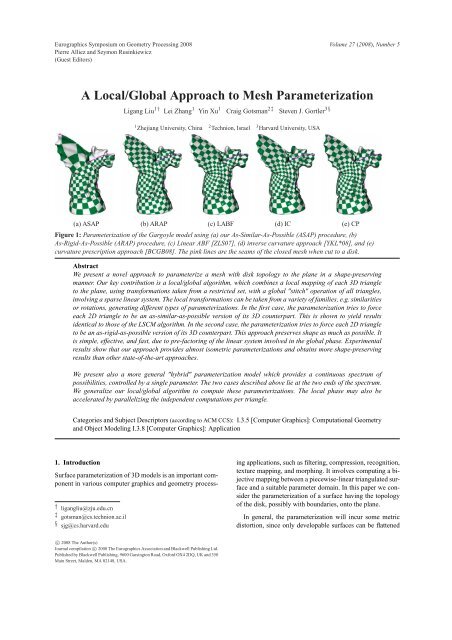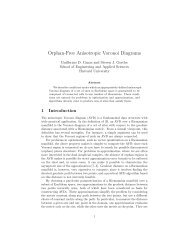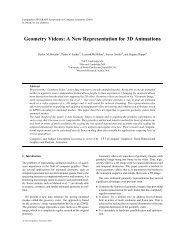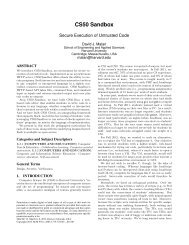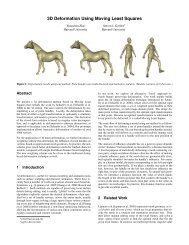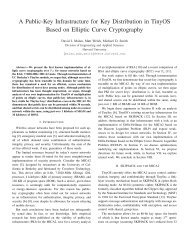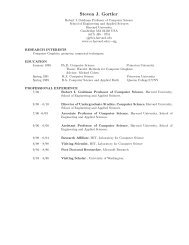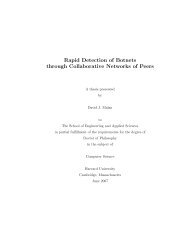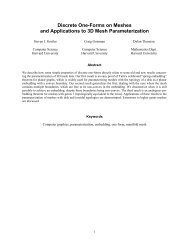A Local/Global Approach to Mesh Parameterization
A Local/Global Approach to Mesh Parameterization
A Local/Global Approach to Mesh Parameterization
You also want an ePaper? Increase the reach of your titles
YUMPU automatically turns print PDFs into web optimized ePapers that Google loves.
Eurographics Symposium on Geometry Processing 2008<br />
Pierre Alliez and Szymon Rusinkiewicz<br />
(Guest Edi<strong>to</strong>rs)<br />
Volume 27 (2008), Number 5<br />
A <strong>Local</strong>/<strong>Global</strong> <strong>Approach</strong> <strong>to</strong> <strong>Mesh</strong> <strong>Parameterization</strong><br />
Ligang Liu 1† Lei Zhang 1 Yin Xu 1 Craig Gotsman 2‡ Steven J. Gortler 3§<br />
1 Zhejiang University, China 2 Technion, Israel 3 Harvard University, USA<br />
(a) ASAP (b) ARAP (c) LABF (d) IC (e) CP<br />
Figure 1: <strong>Parameterization</strong> of the Gargoyle model using (a) our As-Similar-As-Possible (ASAP) procedure, (b)<br />
As-Rigid-As-Possible (ARAP) procedure, (c) Linear ABF [ZLS07], (d) inverse curvature approach [YKL*08], and (e)<br />
curvature prescription approach [BCGB08]. The pink lines are the seams of the closed mesh when cut <strong>to</strong> a disk.<br />
Abstract<br />
We present a novel approach <strong>to</strong> parameterize a mesh with disk <strong>to</strong>pology <strong>to</strong> the plane in a shape-preserving<br />
manner. Our key contribution is a local/global algorithm, which combines a local mapping of each 3D triangle<br />
<strong>to</strong> the plane, using transformations taken from a restricted set, with a global "stitch" operation of all triangles,<br />
involving a sparse linear system. The local transformations can be taken from a variety of families, e.g. similarities<br />
or rotations, generating different types of parameterizations. In the first case, the parameterization tries <strong>to</strong> force<br />
each 2D triangle <strong>to</strong> be an as-similar-as-possible version of its 3D counterpart. This is shown <strong>to</strong> yield results<br />
identical <strong>to</strong> those of the LSCM algorithm. In the second case, the parameterization tries <strong>to</strong> force each 2D triangle<br />
<strong>to</strong> be an as-rigid-as-possible version of its 3D counterpart. This approach preserves shape as much as possible. It<br />
is simple, effective, and fast, due <strong>to</strong> pre-fac<strong>to</strong>ring of the linear system involved in the global phase. Experimental<br />
results show that our approach provides almost isometric parameterizations and obtains more shape-preserving<br />
results than other state-of-the-art approaches.<br />
We present also a more general "hybrid" parameterization model which provides a continuous spectrum of<br />
possibilities, controlled by a single parameter. The two cases described above lie at the two ends of the spectrum.<br />
We generalize our local/global algorithm <strong>to</strong> compute these parameterizations. The local phase may also be<br />
accelerated by parallelizing the independent computations per triangle.<br />
Categories and Subject Descrip<strong>to</strong>rs (according <strong>to</strong> ACM CCS): I.3.5 [Computer Graphics]: Computational Geometry<br />
and Object Modeling I.3.8 [Computer Graphics]: Application<br />
1. Introduction<br />
Surface parameterization of 3D models is an important component<br />
in various computer graphics and geometry process-<br />
† ligangliu@zju.edu.cn<br />
‡ gotsman@cs.technion.ac.il<br />
§ sjg@cs.harvard.edu<br />
c○ 2008 The Author(s)<br />
Journal compilation c○ 2008 The Eurographics Association and Blackwell Publishing Ltd.<br />
Published by Blackwell Publishing, 9600 Garsing<strong>to</strong>n Road, Oxford OX4 2DQ, UK and 350<br />
Main Street, Malden, MA 02148, USA.<br />
ing applications, such as filtering, compression, recognition,<br />
texture mapping, and morphing. It involves computing a bijective<br />
mapping between a piecewise-linear triangulated surface<br />
and a suitable parameter domain. In this paper we consider<br />
the parameterization of a surface having the <strong>to</strong>pology<br />
of the disk, possibly with boundaries, on<strong>to</strong> the plane.<br />
In general, the parameterization will incur some metric<br />
dis<strong>to</strong>rtion, since only developable surfaces can be flattened
on<strong>to</strong> the plane without any dis<strong>to</strong>rtion. Hence, the goal of parameterization<br />
is <strong>to</strong> find a bijective mapping which preserves<br />
some geometric properties of the original as much as possible,<br />
e.g., authalic (area-preserving) mapping, conformal<br />
(angle-preserving) mapping, isometric (length-preserving)<br />
or some combination of these. Each individual triangle may<br />
be easily parameterized without dis<strong>to</strong>rtion, but then they will<br />
no longer fit <strong>to</strong>gether properly in the plane.<br />
Inspired by recent work on mesh deformation and modeling<br />
[IMH05, SA07], we formulate the parameterization<br />
problem as an optimization problem having both local and<br />
global elements. In essence, we seek for local transformations<br />
which minimize the dis<strong>to</strong>rtion of each mesh triangle,<br />
yet require that they all fit <strong>to</strong>gether <strong>to</strong> a coherent 2D<br />
triangulation. We follow closely the method for "as-rigidas-possible"<br />
deformation of triangle meshes described by<br />
Sorkine and Alexa [SA07] for mesh editing purposes, and,<br />
essentially, apply the same methodology <strong>to</strong> the problem of<br />
mesh parameterization.<br />
2. Previous Work<br />
In the past decade, methods for triangular mesh parameterization<br />
have been studied extensively. We refer the interested<br />
reader <strong>to</strong> [FH05] and [SPR06] for a survey of the state-ofthe-art<br />
in parameterization research.<br />
The linear setting for parameterization offers the advantage<br />
of simplicity and validity of parameterization results.<br />
Based on Tutte’s barycentric mapping theorem [Tut63], Eck<br />
et al. [EDD ∗ 95] and Floater [Flo97] described a simple<br />
approach <strong>to</strong> parameterization by representing each interior<br />
vertex as some convex combination of its neighboring vertices.<br />
Depending on the precise weights used, it is possible<br />
<strong>to</strong> achieve a variety of effects, minimizing various dis<strong>to</strong>rtion<br />
measures. The most celebrated weight recipes are<br />
the so-called cotangent weights [PP93], and the so-called<br />
mean-value weights [Flo03], which are both related <strong>to</strong> harmonic<br />
mappings. Unfortunately, the method of barycentric<br />
coordinates requires the boundary of the mesh <strong>to</strong> be fixed<br />
<strong>to</strong> a convex polygon in the plane, which is somewhat arbitrary,<br />
typically resulting in significant dis<strong>to</strong>rtion. Lee et<br />
al. [LKL02] alleviated this somewhat by "padding" the mesh<br />
with a virtual boundary, allowing the true boundary <strong>to</strong> evolve<br />
<strong>to</strong> a less dis<strong>to</strong>rted shape. Desbrun et al. [DMA02] were<br />
able <strong>to</strong> generalize the method of barycentric coordinates<br />
so that also the boundary vertices are free, subject <strong>to</strong> socalled<br />
"natural" boundary conditions - some additional linear<br />
equations. This was shown <strong>to</strong> be equivalent <strong>to</strong> the Least-<br />
Squares Conformal Mapping (LSCM) method of Levy et<br />
al. [LPRM02], which is a least-squares approximation of the<br />
discrete Cauchy-Riemann equations, which define continuous<br />
conformal mappings. These boundary equations were<br />
generalized by Karni et al. [KGG05] <strong>to</strong> a larger family of<br />
barycentric coordinates.<br />
The main problem with linear free-boundary methods is<br />
L. Liu et al. / A <strong>Local</strong>/<strong>Global</strong> <strong>Approach</strong> <strong>to</strong> <strong>Mesh</strong> <strong>Parameterization</strong><br />
that the parameterization is no longer guaranteed <strong>to</strong> be bijective,<br />
meaning that the resulting 2D embedding may contain<br />
local overlaps (also known as "triangle flips"), global overlaps,<br />
or even wind on itself. Karni et al. [KGG05] showed<br />
how <strong>to</strong> solve the more frequent problem of local overlaps in<br />
a postprocessing step.<br />
Some parameterization work focuses on directly optimizing<br />
the dis<strong>to</strong>rtion metrics of length, angle or area. These<br />
approaches require extensive computation, since the dis<strong>to</strong>rtion<br />
measures are usually highly non-linear. Hormann et<br />
al. [HG99] define a deformation-based MIPS energy which<br />
requires a non-linear solver. The compute-intensive ABF<br />
method of Sheffer et al. [SdS00] computes the parameterization<br />
in angle space, with a result minimizing angular<br />
dis<strong>to</strong>rtion. The more efficient ABF++ [SLMB05] and Lin-<br />
ABF [ZLS07] have accelerated this method considerably.<br />
Other metrics are also used <strong>to</strong> guide the optimization process<br />
for parameterization, such as stretch. These are based<br />
on the singular values of the Jacobian matrix of the parameterization<br />
mapping [SSGH01], on the Green-Lagrange<br />
tensor [MYV93, ZMT05] or the synthesized dis<strong>to</strong>rtion metric<br />
[YYS06].<br />
Other improvements on the method of barycentric coordinates<br />
were proposed by Zayer et al. [ZRS05a, ZRS05b]<br />
and Yoshizawa et al. [YBS04], who showed how <strong>to</strong> dynamically<br />
adjust the barycentric weights such that the system converges<br />
<strong>to</strong> a parameterization minimizing stretch.<br />
Another approach <strong>to</strong> parameterization is inspired by recent<br />
advances in dimension reduction and manifold learning<br />
[LYD ∗ 05, ZKK02]. The basic principle is <strong>to</strong> preserve<br />
some geometric property like geodesic distance of a higher<br />
dimensional data set while embedding it in a lower dimensional<br />
space. For example, Chen et al. [CLZW07] introduce<br />
a new parameterization technique based on local tangent<br />
space alignment (LTSA), which tries <strong>to</strong> embed each onering<br />
of the mesh in some optimal manner in the plane, and<br />
then solves a global linear system <strong>to</strong> "stitch" the one-rings<br />
<strong>to</strong>gether <strong>to</strong> one coherent triangle mesh. In this sense, it is the<br />
closest <strong>to</strong> the approach we describe in this paper.<br />
A series of very recent works on conformal parameterizations<br />
by Yang et al. [YKL ∗ 08], Ben-Chen et al. [BCGB08]<br />
and Springborn et al. [SSP08] manipulate the curvature distribution<br />
on a 3D mesh, flattening it by migrating the <strong>to</strong>tal<br />
curvature so that it is distributed on only a small number of<br />
so-called "cone singularities". The other mesh vertices retain<br />
no curvature. For the case of a mesh having disk <strong>to</strong>pology<br />
with a given boundary, this means concentrating the curvature<br />
on the boundary alone. In practice it amounts <strong>to</strong> computing<br />
new lengths for the mesh edges, so that they can be embedded<br />
in the plane. Once the 2D edge lengths are computed,<br />
the final 2D embedding is computed either by an incremental<br />
layout process, or by solving a simple sparse linear system<br />
(which happens <strong>to</strong> be identical <strong>to</strong> the LSCM process<br />
mentioned later in this paper, since that process reproduces<br />
c○ 2008 The Author(s)<br />
Journal compilation c○ 2008 The Eurographics Association and Blackwell Publishing Ltd.
a planar embedding). The difference between the three methods<br />
is the precise algorithm used <strong>to</strong> manipulate the curvature<br />
distribution. These methods, although designed <strong>to</strong> minimize<br />
only conformal (i.e. angular) dis<strong>to</strong>rtion, in practice produce<br />
parameterizations with not <strong>to</strong>o much stretch. They are also<br />
relatively easy <strong>to</strong> compute, thus are strong contenders for use<br />
in conformal parameterization scenarios.<br />
3. Contribution<br />
We apply the methodology of Sorkine and Alexa [SA07] for<br />
mesh editing (which has its origins in a series of papers starting<br />
with Sorkine et al. [SCOL ∗ 04]) <strong>to</strong> the problem of mesh<br />
parameterization. This poses the problem as that of finding<br />
optimal local transformations for each individual mesh element<br />
from an appropriate family and then "stitching" the<br />
transformed triangles <strong>to</strong>gether <strong>to</strong> a 2D mesh. As opposed<br />
<strong>to</strong> [SA07], where the local transformations are applied <strong>to</strong><br />
one-rings of a vertex and its neighbors, we apply the local<br />
transformations <strong>to</strong> individual triangles. This then becomes a<br />
proper finite-element discretization of an associated continuous<br />
problem. In this context, our contributions are:<br />
• For the case of local similarity transformations, our<br />
method is shown <strong>to</strong> be equivalent <strong>to</strong> the well known<br />
Least-Squares Conformal Mapping (LSCM) method<br />
[LPRM02].<br />
• For the case of local rotational transformations, we provide<br />
an efficient and simple iterative "local/global" algorithm<br />
<strong>to</strong> solve the problem. This leads <strong>to</strong> a parameterization<br />
which is close <strong>to</strong> isometric and shown <strong>to</strong> be superior<br />
<strong>to</strong> competing algorithms. Additionally, the algorithm<br />
minimizes an "intrinsic" deformation energy function that<br />
may be expressed in terms of the singular values of the<br />
Jacobian of the parameterization, as is the case for many<br />
other dis<strong>to</strong>rtion measures. The algorithm is shown <strong>to</strong> be<br />
very fast, due <strong>to</strong> pre-fac<strong>to</strong>ring of the linear system involved<br />
in the global step, and optional parallel processing<br />
in the local phase.<br />
• We propose a more general "hybrid" parameterization<br />
model which provides a continuous spectrum of possibilities,<br />
controlled by a single parameter. The two cases<br />
described above (similarities and rotations) lie at the two<br />
ends of the spectrum. The hybrid parameterization may<br />
also be computed using a similar local/global algorithm.<br />
4. The General <strong>Local</strong>/<strong>Global</strong> <strong>Approach</strong><br />
If each triangle of the 3D triangle mesh were required <strong>to</strong> be<br />
flattened <strong>to</strong> the plane independently of the other triangles,<br />
this would certainly be easy. Requiring that all the flattened<br />
triangles fit <strong>to</strong>gether in<strong>to</strong> one mesh with the correct orientations<br />
is the main challenge (see Figure 2). Obviously some<br />
of the triangles are going <strong>to</strong> be deformed in the process. Assume<br />
we allow each triangle <strong>to</strong> be deformed by some subset<br />
of the 2D linear transformations, in the sense that this transformation<br />
"does not count" as a deformation. For example,<br />
c○ 2008 The Author(s)<br />
Journal compilation c○ 2008 The Eurographics Association and Blackwell Publishing Ltd.<br />
L. Liu et al. / A <strong>Local</strong>/<strong>Global</strong> <strong>Approach</strong> <strong>to</strong> <strong>Mesh</strong> <strong>Parameterization</strong><br />
translations of the triangles are obviously allowed. A conformal<br />
parameterization would also allow each triangle <strong>to</strong> undergo<br />
a similarity transformation (only). An isometry would<br />
allow only a rotation. An authalic parameterization would<br />
allow only transformations with unit determinant.<br />
Figure 2: Parameterizing a mesh by aligning locally flattened<br />
triangles. (Left) Original 3D mesh; (middle) flattened<br />
triangles; (right) 2D parameterization.<br />
Assume the triangles of the 3D triangle mesh are numbered<br />
with t = 1 <strong>to</strong> T and the area of the 3D triangles are<br />
At. Assume that each 3D triangle is equipped with its own<br />
local isometric parameterization using a triangle in the plane<br />
xt = {x 0 t ,x 1 t ,x 2 t }. Our goal is <strong>to</strong> find a single parameterization<br />
of the entire mesh, i.e., a piecewise linear mapping from the<br />
3D mesh <strong>to</strong> the 2D plane, described by assigning 2D coordinates<br />
u <strong>to</strong> each of the n vertices. For triangle t, let us denote<br />
these 2D coordinates as ut = {u 0 t ,u 1 t ,u 2 t }. Given this setup,<br />
the mapping between xt and ut has an associated 2 × 2 Jacobian<br />
matrix which is constant per triangle. We denote this<br />
matrix at triangle t as Jt(u) <strong>to</strong> express its dependence on the<br />
u. It represents the linear portion of the affine mapping from<br />
the triangle described by xt <strong>to</strong> the triangle described by ut.<br />
In our method, we will also assign an auxiliary linear transformation<br />
(2×2 matrix) Lt <strong>to</strong> each triangle taken from some<br />
family of allowed transformations M (in particular, we will<br />
consider, in turn, M <strong>to</strong> be the similarity transformations, and<br />
later, the rotations).<br />
Define the energy of the parameterization coordinates<br />
u and an auxiliary set of T linear transformations L =<br />
{L1,..,LT } <strong>to</strong> be<br />
T<br />
E(u,L) = ∑ At �Jt(u) − Lt�<br />
t=1<br />
2<br />
F<br />
where �·� F is the Frobenius norm. Following Pinkall and<br />
Polthier [PP93], this energy may be rewritten in terms of the<br />
coordinates x and u (instead of in terms of the Jacobians) in<br />
an explicit form (in terms of the mesh vertex coordinates):<br />
E(u,L)<br />
= 1 T 2<br />
2 ∑ ∑ cot(θ<br />
t=1i=0<br />
i �<br />
�<br />
t) �(u i t − u i+1<br />
t ) − Lt(x i t − x i+1<br />
�<br />
�<br />
t ) � 2 (1)<br />
where θ i t is the angle opposite the edge (x i t,x i+1<br />
t ) in the triangle<br />
whose vertices are xt and superscripts are all modulo
2. Note that some of the u i t are identical, as they are shared<br />
by more than one triangle in the mesh.<br />
We would like <strong>to</strong> solve the following optimization problem:<br />
L. Liu et al. / A <strong>Local</strong>/<strong>Global</strong> <strong>Approach</strong> <strong>to</strong> <strong>Mesh</strong> <strong>Parameterization</strong><br />
(u,L) = argmin (u,L) E(u,L) s.t. Lt ∈ M (2)<br />
Namely, find a set of n 2D coordinates u for the mesh vertices<br />
and T matrices L1 ,.., LT in M such that the Jacobians<br />
of the transformation from the given x <strong>to</strong> the u are closest <strong>to</strong><br />
the Lt.<br />
Although we solve for both u and L, in the end we are<br />
interested only in u while L plays an auxiliary role only. As<br />
we shall see below, in many cases, the optimal u may be<br />
defined as that minimizing an energy function formulated in<br />
terms of the singular values of the Jacobians Jt(u). In the<br />
next sections, we will examine a number of interesting cases<br />
for M and relate our energy functions <strong>to</strong> those.<br />
4.1. Best fitting L matrix<br />
Suppose we are asked <strong>to</strong> approximate one 2 × 2 matrix J as<br />
best we can by another 2×2 matrix L, where L is taken from<br />
a restricted set of transformations M (we will consider in turn<br />
similarities and rotations) and where distance is measured<br />
using the Frobenius matrix norm. In other words:<br />
d(J,L) = �J − L� 2<br />
�<br />
F = tr (J − L) T �<br />
(J − L)<br />
This problem can be solved using Procrustes analysis<br />
[GD04], and its solution in general is computed using<br />
the Singular Value Decomposition (SVD) of J.<br />
In particular, using SVD, J may be written as<br />
J = UΣV T<br />
where U and V are orthonormal, and Σ is a diagonal matrix:<br />
�<br />
σ1<br />
Σ =<br />
0<br />
0<br />
σ2<br />
�<br />
We use here a "signed version" of the SVD, where the determinant<br />
of UV T is constrained <strong>to</strong> be positive, σ1 is positive<br />
and σ2 may be positive or negative. We refer <strong>to</strong> these<br />
σ as signed singular values. This signed version is needed<br />
<strong>to</strong> constrain our Procrustes solutions <strong>to</strong> exclude orientation<br />
reversing transformations.<br />
Given this decomposition, it is easy <strong>to</strong> show that the optimal<br />
rotation minimizing the distance d(J,L) is obtained by<br />
setting both singular values <strong>to</strong> 1, i.e. L = UV T . Similarly,<br />
the optimal similarity transform is obtained by setting both<br />
singular values <strong>to</strong> (σ1 + σ2)/2. See Figure 3 for examples.<br />
4.2. As-similar-as-possible (ASAP) mappings<br />
Conformal mappings are those which preserve angles, which<br />
are invariant under similarity transformations. Thus, in order<br />
<strong>to</strong> produce a conformal-type parameterization, the family<br />
Figure 3: Optimal Procrustes transformations: Left: source<br />
triangle; Right: target triangle in black, optimal similarity<br />
of source in red, optimal rotated version of source in green.<br />
M of allowed transformations should be similarities, which<br />
may be parameterized as all matrices of the form:<br />
�� � �<br />
a b<br />
M =<br />
: a,b ∈ R<br />
(3)<br />
−b a<br />
Thus we may represent the allowed Lt in the energy function<br />
(2) with the variables a = (a1,..,aT ), b = (b1,..,bT ).<br />
Since the x i t and θ i t are fixed, the energy function is quadratic<br />
in the variables a,b,u and thus may be minimized by solving<br />
a large sparse linear system with these variables.<br />
Since we try <strong>to</strong> stay close <strong>to</strong> the family of similarity<br />
transformations, we call this parameterization "as-similaras-possible"<br />
(ASAP). Appendix A proves that solving (2)<br />
with this M is equivalent <strong>to</strong> finding the u that minimizes<br />
Lévy’s conformal energy:<br />
T<br />
∑ At(σ1,t − σ2,t)<br />
t=1<br />
2<br />
where σ1,t and σ2,t are the signed singular values of Jt<br />
– the Jacobian of the t-th triangle’s transformation. Since<br />
the Least-Square Conformal mapping (LSCM) technique<br />
[LPRM02] also minimizes precisely this energy, the two<br />
techniques are equivalent.<br />
As with LSCM, for non-developable meshes, the (trivial)<br />
solution that collapses all of the vertices <strong>to</strong> a single point<br />
in the plane achieves a global minimum – zero energy. This<br />
can be avoided by constraining two vertices <strong>to</strong> two different<br />
locations in the plane. In practice, we pin down the two<br />
vertices most distant from each other (the diameter) in the<br />
mesh.<br />
4.3. As-rigid-as-possible (ARAP) mappings<br />
While conformal mappings have many nice mathematical<br />
properties, they are not always exactly what the application<br />
needs. The fact that arbitrary scaling fac<strong>to</strong>rs may creep<br />
in<strong>to</strong> the parameterization makes it unsuitable for applications<br />
which try <strong>to</strong> minimize "stretch" and preserve the proportions<br />
of the triangles.<br />
To obtain an "as-rigid-as-possible" mapping we limit the<br />
c○ 2008 The Author(s)<br />
Journal compilation c○ 2008 The Eurographics Association and Blackwell Publishing Ltd.
family of allowed local transformations <strong>to</strong> be just rotations:<br />
��<br />
M =<br />
cosθ<br />
−sinθ<br />
sinθ<br />
cosθ<br />
�<br />
�<br />
: θ ∈ [0,2π)<br />
Or, in other words, the same as (3), only with the extra requirement<br />
that a 2 + b 2 = 1.<br />
Appendix A proves that solving (2) with this M is equivalent<br />
<strong>to</strong> finding the u which minimizes<br />
T �<br />
∑ At (σ1,t − 1)<br />
t=1<br />
2 + (σ2,t − 1) 2�<br />
This energy is similar <strong>to</strong> the Green-Lagrange energy<br />
� [MYV93, ZMT05], which uses terms of the form<br />
(σ 2 1,t − 1)2 + (σ 2 2,t − 1)2� and also produces parameterizations<br />
which are close <strong>to</strong> isometric.<br />
Alas, the extra condition on Lt in (1) means that the energy<br />
function may no longer be minimized by solving a linear<br />
system.<br />
4.4. <strong>Local</strong>/<strong>Global</strong> Algorithm<br />
To solve the minimization problem (2) for an ARAP mapping,<br />
we adapt the local/global algorithm of [SA07]. This<br />
iterates between two phases. In the first local phase, the optimal<br />
rotation Lt is computed per triangle, assuming the u<br />
are fixed. Then, in the second global phase, the Lt are assumed<br />
fixed, and the optimal u are solved for as a sparse<br />
linear system. (Recall that xt are fixed throughout the algorithm.)<br />
Since each step is guaranteed <strong>to</strong> reduce the energy,<br />
this energy will eventually converge. Additionally, since the<br />
matrix of the global phase is unchanged from iteration <strong>to</strong> iteration,<br />
it only has <strong>to</strong> be fac<strong>to</strong>red once and reused at each<br />
iteration.<br />
4.4.1. <strong>Local</strong> Phase<br />
The local phase can be solved using the SVD fac<strong>to</strong>rization of<br />
J as described in Section 4.1. Equivalently, and analogously<br />
<strong>to</strong> [SA07], for ARAP one can also perform the SVD fac<strong>to</strong>rization<br />
directly on the following "cross-covariance" matrix<br />
in place of Jt(u)<br />
2<br />
St(u) = ∑ cot(θ<br />
i=0<br />
i t)(u i t − u i+1<br />
t )(x i t − x i+1<br />
t ) T<br />
4.4.2. <strong>Global</strong> Phase<br />
For fixed Lt, the energy E(u,L) is quadratic in u. The minimum<br />
u can be found by setting the gradients of (1) <strong>to</strong> zero<br />
and solving the associated linear system. To calculate this,<br />
overloading the notation slightly, we rewrite the energy function<br />
in terms of the mesh half-edges:<br />
c○ 2008 The Author(s)<br />
Journal compilation c○ 2008 The Eurographics Association and Blackwell Publishing Ltd.<br />
L. Liu et al. / A <strong>Local</strong>/<strong>Global</strong> <strong>Approach</strong> <strong>to</strong> <strong>Mesh</strong> <strong>Parameterization</strong><br />
E(u,L)<br />
= 1 T 2<br />
2 ∑ ∑ cot(θ<br />
t=1i=0<br />
i �<br />
�<br />
t) �(u i t − u i+1<br />
t ) − Lt(x i t − x i+1<br />
�<br />
�<br />
t ) � 2<br />
= 1 �<br />
�<br />
�<br />
�<br />
2 ∑ cot(θi j) �(ui − u j) − Lt(i, j)(xi − x j) �<br />
(i, j)∈he<br />
2<br />
where he is the set of half-edges in the mesh, ui and xi are<br />
coordinates of vertices i, t(i, j) is the triangle containing the<br />
half-edge (i, j), and θi j is the angle opposite (i, j) in t(i, j).<br />
Setting the gradient <strong>to</strong> zero, we obtain the following set of<br />
linear equations for u.<br />
�<br />
∑ cot(θi j) + cot(θ ji)<br />
j∈N(i)<br />
� (ui − u j)<br />
= ∑<br />
j∈N(i)<br />
�<br />
�<br />
cot(θi j)Lt(i, j) + cot(θ ji)Lt( j,i) (xi − x j),<br />
∀ i = 1,..,n.<br />
The entries of the associated matrix depend only on the<br />
geometry of the input 3D mesh. Thus this sparse matrix is<br />
fixed throughout the algorithm, allowing us <strong>to</strong> pre-fac<strong>to</strong>r it<br />
(e.g. with Cholesky decomposition) [GvL05, In0] and reuse<br />
the fac<strong>to</strong>rization many times throughout the algorithm in order<br />
<strong>to</strong> accelerate the process. This has a significant impact<br />
on algorithm efficiency.<br />
Unfortunately, stitching the triangles using a global Poisson<br />
equation may result in some triangles "flipping" their<br />
orientation especially for a highly curved surface with compact<br />
boundary. We solve this with a final post-processing<br />
phase, e.g., the "convex virtual boundary" algorithm of Karni<br />
et al. [KGG05]. Since in most cases, there are only a few<br />
flips, sprinkled throughout the parameterization, the postprocessing<br />
solves the flips without changing much else.<br />
4.5. The initial parameterization<br />
Our local/global algorithm requires an initial parameterization<br />
M <strong>to</strong> start it off. The basic requirement from the initial<br />
parameterization is that it be a valid embedding (contain<br />
no flips) reasonably close <strong>to</strong> a parameterization with not<br />
<strong>to</strong>o much dis<strong>to</strong>rtion, and be fast <strong>to</strong> generate. Candidates are<br />
the shape-preserving method [Flo97] and LSCM [LPRM02]<br />
as they can be computed quickly. We found the shapepreserving<br />
parameterization more suitable for meshes with<br />
one boundary, and LSCM [LPRM02] for meshes with multiple<br />
boundaries. The experimental results shown in Section<br />
6 are obtained using these initial parameterizations.<br />
We tested the sensitivity of our algorithm <strong>to</strong> different<br />
types of M’s, as mentioned above. We found that the algorithm<br />
is not sensitive <strong>to</strong> M at all. Figure 4 shows the progress<br />
of the iterative algorithm when initialized with the shapepreserving<br />
parameterization and LSCM. Both converge fast<br />
and stably.<br />
(4)
L. Liu et al. / A <strong>Local</strong>/<strong>Global</strong> <strong>Approach</strong> <strong>to</strong> <strong>Mesh</strong> <strong>Parameterization</strong><br />
Initial guess 1 Iteration 3 Iterations Final result<br />
Figure 4: Successive iterations of the local/global ARAP algorithm. (Top) Initialized using Floater’s shape-preserving parameterization<br />
[Flo97]. (Bot<strong>to</strong>m) Lower row: Initialized using LSCM parameterization [LPRM02].<br />
5. The Hybrid Model<br />
Our ASAP parameterization belongs <strong>to</strong> the family of (approximately)<br />
conformal maps and may be computed easily<br />
by solving a simple linear system. However, it is not<br />
the most area-preserving among the conformal parameterizations,<br />
and, in fact, the non-linear ABF++ method preserves<br />
area much better, while still being approximately conformal.<br />
On the other hand, our ARAP parameterization preserves areas<br />
much better, but since it it strives <strong>to</strong> be isometric, it might<br />
damage the conformality in this effort. We now present an<br />
energy function which is a generalization of (1), which provides<br />
a means <strong>to</strong> generate a parameterization anywhere between<br />
ASAP and ARAP. The two latter are endpoints of<br />
the spectrum, and the result is controlled by a parameter<br />
λ ∈ [0,∞).<br />
The hybrid energy function is<br />
E(u,a,b)<br />
�<br />
=<br />
T 2<br />
1<br />
2 ∑ ∑ cot(θ<br />
t=1 i=0<br />
i �<br />
�<br />
t) �∇e i �<br />
�<br />
t�<br />
2<br />
+ λ(a 2 t + b 2 t − 1) 2<br />
�<br />
,<br />
where<br />
∇e i t = (u i t − u i+1<br />
�<br />
at bt<br />
t ) −<br />
−bt at<br />
�<br />
(x i t − x i+1<br />
t ).<br />
Setting λ=0 will be equivalent <strong>to</strong> ASAP while a very large<br />
value of λ will be equivalent <strong>to</strong> ARAP. Any value inbetween<br />
will yield an intermediate parameterization, so the<br />
user may control the tradeoff between conformality and<br />
area-preservation.<br />
(5)<br />
Solving for the parameterization coordinates u which<br />
minimize E(u,a,b) involves solving also for the auxiliary<br />
vec<strong>to</strong>rs of unknowns of the similarity transformations a and<br />
b. The value of λ indicates how much we want <strong>to</strong> force the<br />
similarity <strong>to</strong> be a rotation. A local/global algorithm similar <strong>to</strong><br />
that we use for solving for the ARAP parameterization may<br />
be used here as well, i.e. iterate while alternating between<br />
two phases: one local and one global. Recall that x is fixed<br />
(derived directly from the input 3D mesh). The local phase<br />
keeps the parameterization coordinates u fixed and solves for<br />
the optimal at and bt per triangle t. Examination of (5) reveals<br />
that this involves solving two cubic equations in at and<br />
bt. Furthermore, this reduces <strong>to</strong> a single cubic equation in at,<br />
(Equation (B3) in Appendix B), which may be solved analytically.<br />
The global phase keeps both vec<strong>to</strong>rs a and b fixed<br />
and solves a global sparse linear system (similar <strong>to</strong> (4)) for<br />
u. Since the matrix of the linear system is fixed throughout<br />
all iterations, it may be pre-fac<strong>to</strong>red at the beginning, and<br />
reused in all iterations thereafter. Thus the runtime of the<br />
procedure is dominated by the first iteration. This makes for<br />
a simple and efficient algorithm.<br />
6. Experimental Results and Comparison<br />
We have applied our approach <strong>to</strong> parameterize a variety<br />
of 3D meshes and compared with other relevant methods.<br />
These include LSCM (equivalent <strong>to</strong> our ASAP method)<br />
[LPRM02], direct ABF++ (ABF++ without the hierarchical<br />
solver) [SLMB05], which we label dABF++, linear<br />
ABF [ZLS07], which we label LABF, inverse curvature<br />
c○ 2008 The Author(s)<br />
Journal compilation c○ 2008 The Eurographics Association and Blackwell Publishing Ltd.
ASAP (¡ =0)<br />
(2.05, 15.4)<br />
=0.0001<br />
(2.05, 5.74)<br />
L. Liu et al. / A <strong>Local</strong>/<strong>Global</strong> <strong>Approach</strong> <strong>to</strong> <strong>Mesh</strong> <strong>Parameterization</strong><br />
=0.001<br />
(2.07, 2.88)<br />
=0.1<br />
(2.18, 2.14)<br />
ARAP ( =∞)<br />
(2.19, 2.11)<br />
LABF<br />
(2.12, 9.12)<br />
IC<br />
(3.09, 3.91)<br />
CP<br />
(2.29, 11.9)<br />
Figure 5: Isis model: Effect of λ in hybrid energy function (5) compared with results of other algorithms. Numbers in brackets<br />
denote angular dis<strong>to</strong>rtion and area dis<strong>to</strong>rtion.<br />
ASAP ( =0) (2.02, 2.42)<br />
=10 -4 (2.02, 2.31)<br />
ARAP (¡ =∞) (2.07, 2.04) LABF (2.05, 2.34)<br />
=10 -3 (2.03, 2.15)<br />
=10 -1 (2.07, 2.05)<br />
IC (2.06, 2.42) CP (2.36, 3.18)<br />
Figure 6: Balls model: Effect of λ in hybrid energy function (5) compared with results of other algorithms. Numbers in brackets<br />
denote angular dis<strong>to</strong>rtion and area dis<strong>to</strong>rtion.<br />
[YKL ∗ 08], which we label IC, and curvature prescription<br />
[BCGB08], which we label CP. We show some results in<br />
Fig. 1 and Figs. 5-8. In our algorithm, we used the sparse<br />
Cholesky linear solver [In0] for the global systems and the<br />
analytic solution <strong>to</strong> Equation (B3) for the local systems. The<br />
IC results were kindly provided by Yang and the CP results<br />
by Ben-Chen, the authors of those methods, who ran their<br />
own software. The results of LABF where obtained by running<br />
software kindly provided by Zayer.<br />
Computing the ASAP parameterization involves the solution<br />
of one sparse linear system, thus is very fast. Computing<br />
ARAP involves running the local/global algorithm. This<br />
converged in up <strong>to</strong> 10 iterations in all our experiments. Computing<br />
the hybrid also involves an iterative local/global algo-<br />
c○ 2008 The Author(s)<br />
Journal compilation c○ 2008 The Eurographics Association and Blackwell Publishing Ltd.<br />
rithm, but with the local phase using the analytic solution <strong>to</strong><br />
Equation (B3) instead of a simple 2 × 2 SVD operation.<br />
The figures show the parameterizations resulting from<br />
ASAP, ARAP and the hybrid method with some interesting<br />
values of λ. These are compared with the results of<br />
the other algorithms. The runtime of our local/global procedure<br />
is comparable <strong>to</strong> the state-of-the-art ABF++. Our local/global<br />
parameterization method may be applied also <strong>to</strong><br />
meshes with multiple boundaries. Fig. 8 shows one such result.<br />
The LABF method is not applicable <strong>to</strong> such inputs.<br />
To quantify the parameterization dis<strong>to</strong>rtion, we compute<br />
both the angle and area dis<strong>to</strong>rtion metric defined using the<br />
signed singular values σ1,t and σ2,t of the Jacobians Jt for
L. Liu et al. / A <strong>Local</strong>/<strong>Global</strong> <strong>Approach</strong> <strong>to</strong> <strong>Mesh</strong> <strong>Parameterization</strong><br />
ASAP ARAP<br />
dABF++<br />
LABF<br />
IC<br />
Figure 7: Cow model: Comparison with other algorithms. The pink lines are the seams of the closed mesh when cut <strong>to</strong> a disk.<br />
Triangulations are the 2D parameterizations.<br />
dABF++<br />
ARAP<br />
Figure 8: Beetle model with multiple boundaries: (Left) Direct<br />
ABF++. (Right) ARAP.<br />
each triangle, as defined in [HG99, DMK03]:<br />
D angle �<br />
= ∑ρt σ<br />
t<br />
1 t /σ 2 t + σ 2 t /σ 1 �<br />
t<br />
D area �<br />
= ∑ρt σ<br />
t<br />
1 t σ 2 t + 1/(σ 1 t σ 2 �<br />
t )<br />
where the weight ρt is<br />
ρt = At/∑At t<br />
and At is the area of triangle t. The values of the dis<strong>to</strong>rtion<br />
measures obtained by the various algorithms is summarized<br />
in Table 1. As is evident in the table, our ARAP parameterization<br />
consistently gives the best value of D area , at a very<br />
small, even insignificant, penalty in D angle . It is possible <strong>to</strong><br />
significantly improve the value of D area relative <strong>to</strong> LSCM<br />
even by introducing a small value of λ.<br />
7. Discussion and Conclusion<br />
We have presented a novel approach <strong>to</strong> parameterization of<br />
3D mesh surfaces, by minimizing a very general energy<br />
function. We have also provided a simple and efficient local/global<br />
algorithm for computing these parameterizations.<br />
The local component of the algorithm tries <strong>to</strong> minimize dis<strong>to</strong>rtion<br />
of the individual 2D triangles relative <strong>to</strong> the original<br />
3D mesh geometry, while the global component guarantees<br />
that the resulting 2D triangles fit <strong>to</strong>gether in a coherent<br />
manner. Both phases may be computed efficiently, the local<br />
one taking advantage of parallelism (possibly on the GPU),<br />
and the global one taking advantage of efficient sparse linear<br />
solvers with fac<strong>to</strong>rization.<br />
We have shown that our ASAP definition is equivalent<br />
<strong>to</strong> LSCM, while ARAP can yield more shape-preserving<br />
results compared with other contemporary methods. A hybrid<br />
model, coupled with a similar efficient local/global algorithm,<br />
allows <strong>to</strong> obtain parameterizations anywhere inbetween<br />
these two. While we have applied this method <strong>to</strong><br />
parameterizing meshes with disk <strong>to</strong>pology only, it seems it<br />
could be possible <strong>to</strong> use the same methodology for higher<br />
genus meshes, possibly through the use of one-forms. Positional<br />
constraints on some of the vertices in parameter space<br />
can also be imposed without complicating the algorithm, as<br />
these types of (hard or soft) constraints may be easily incorporated<br />
in<strong>to</strong> the energy functions we optimize.<br />
c○ 2008 The Author(s)<br />
Journal compilation c○ 2008 The Eurographics Association and Blackwell Publishing Ltd.<br />
CP
L. Liu et al. / A <strong>Local</strong>/<strong>Global</strong> <strong>Approach</strong> <strong>to</strong> <strong>Mesh</strong> <strong>Parameterization</strong><br />
Table 1: Comparison of dis<strong>to</strong>rtion measures of different parameterization methods.<br />
D angle<br />
D area<br />
Model<br />
LSCM dABF LABF IC CP ARAP LSCM dABF LABF IC CP ARAP<br />
Gargoyle 2.00 2.00 2.00 2.05 2.00 2.06 88.14 2.64 2.64 2.67 2.64 2.05<br />
Isis 2.05 2.08 2.12 3.09 2.29 2.19 15.36 8.37 9.12 3.91 11.94 2.11<br />
Balls 2.02 2.06 2.05 2.06 2.36 2.07 2.40 2.35 2.34 2.42 3.18 2.04<br />
Cow 2.01 2.01 2.01 2.46 2.01 2.03 30.09 2.19 2.22 2.51 2.18 2.03<br />
Beetle 2.00 2.00 - 2.02 2.00 2.01 2.08 2.09 - 2.14 2.10 2.01<br />
Our local/global algorithm embodies the motif "think<br />
globally, act locally", which is emerging as a powerful technique<br />
in geometry processing. This paper and others [DG07]<br />
have applied this <strong>to</strong> the problem of mesh parameterization<br />
and future work will address other applications where the<br />
technique may also be very effective.<br />
Acknowledgements<br />
Thanks <strong>to</strong> Yongliang Yang and Miri Ben-Chen for providing results<br />
of the algorithms of [YKL ∗ 08] and [BCGB08]. Thanks also<br />
<strong>to</strong> Hugues Hoppe for his many helpful insights on this <strong>to</strong>pic. This<br />
work is supported by National Natural Science Foundation of China<br />
(grants # 60776799, 60503067). Craig Gotsman and Steven Gortler<br />
were partially supported by United States - Israel Binational Science<br />
Foundation grant # 2006089.<br />
References<br />
[BCGB08] BEN-CHEN M., GOTSMAN C., BUNIN G.: Conformal<br />
flattening by curvature prescription and metric scaling. Computer<br />
Graphics Forum 27, 2 (2008), 449–458. (Proc. Eurographics<br />
2008). 2, 7, 9<br />
[CLZW07] CHEN Z. G., LIU L. G., ZHANG Z. Y., WANG G. J.:<br />
Surface parameterization via aligning optimal local flattening.<br />
In Proc. Symposium on Solid and Physical Modeling (2007),<br />
pp. 291–296. 2<br />
[DG07] DONG S., GARLAND M.: Iterative methods for improving<br />
mesh parameterizations. In Proc. IEEE Shape Modeling International<br />
(2007), pp. 119–210. 9<br />
[DMA02] DESBRUN M., MEYER M., ALLIEZ P.: Intrinsic parameterization<br />
of surface meshes. Computer Graphics Forum 21,<br />
3 (2002), C209–C218. (Proc. Eurographics’02). 2<br />
[DMK03] DEGENER P., MESETH J., KLEIN R.: An adaptable<br />
surface parameterization method. In Proc. of 12th International<br />
<strong>Mesh</strong>ing Roundtable (2003), pp. 227–237. 8<br />
[EDD ∗ 95] ECK M., DEROSE T., DUCHAMP T., HOPPE H.,<br />
LOUNSBERY M., STUETZLE W.: Multiresolution analysis of<br />
arbitrary meshes. In Proc. Siggraph’95 (1995), pp. 173–182. 2<br />
[FH05] FLOATER M. S., HORMANN K.: Surface parameterization:<br />
a tu<strong>to</strong>rial and survey. In Advances in Multiresolution for<br />
Geometric Modeling (2005), pp. 157–186. 2<br />
[Flo97] FLOATER M. S.: <strong>Parameterization</strong> and smooth approximation<br />
of surface triangulations. Computer Aided Geometry Design<br />
14 (1997), 231–250. 2, 5<br />
c○ 2008 The Author(s)<br />
Journal compilation c○ 2008 The Eurographics Association and Blackwell Publishing Ltd.<br />
[Flo03] FLOATER M.: Mean value coordinates. Computer Aided<br />
Geometric Design 20, 1 (2003), 19–27. 2<br />
[GD04] GOWER J. C., DIJKSTERHUIS G. B.: Procrustes Problems.<br />
Oxford University Press, 2004. 4<br />
[GvL05] GOLUB G. H., VAN LOAN C. F.: Matrix Computation.<br />
Johns Hopkins Studies in Mathematical Sciences, 2005. 5<br />
[HG99] HORMANN K., GREINER G.: MIPS: an efficient global<br />
parameterization method. In Proc. Curves and Surfaces (1999),<br />
pp. 153–162. 2, 8<br />
[IMH05] IGARASHI T., MOSCOVICH T., HUGHES J. F.: Asrigid-as-possible<br />
shape manipulation. ACM TOG 24, 3 (2005),<br />
C1134–C1141. (Proc. Siggraph’05). 2<br />
[In0] Intel math kernel library. http://developer.intel.com.<br />
5, 7<br />
[KGG05] KARNI Z., GOTSMAN C., GORTLER S. J.: Freeboundary<br />
linear parameterization of 3D meshes in the presence<br />
of constraints. In Proc. IEEE Shape Modeling and Applications<br />
(2005), pp. 268–277. 2, 5<br />
[LKL02] LEE Y., KIM H. S., LEE S.: <strong>Mesh</strong> parameterization<br />
with a virtual boundary. Computer and Graphics 26, 5 (2002),<br />
677–686. 2<br />
[LPRM02] LÉVY B., PETITJEAN S., RAY N., MAILLOT J.:<br />
Least squares conformal maps for au<strong>to</strong>matic texture atlas generation.<br />
ACM TOG 21, 3 (2002), C362–C371. (Proc. Siggraph’02).<br />
2, 3, 4, 5, 6, 10<br />
[LYD ∗ 05] LIU Y. S., YU P. Q., DU M. C., YONG J. H., ZHANG<br />
H., PAUL J. C.: <strong>Mesh</strong> parameterization for an open connected<br />
surface without partition. In Proc. of Computer Aided Design<br />
and Computer Graphics (2005), pp. 306–312. 2<br />
[MYV93] MAILLOT J., YAHIA H., VERROUST A.: Interactive<br />
texture mapping. In Proc. Siggraph’93 (1993), pp. 27–34. 2, 5<br />
[PP93] PINKALL U., POLTHIER K.: Computing discrete minimal<br />
surface and their conjugates. Experimental Mathematics 2,<br />
1 (1993), 15–36. 2, 3<br />
[SA07] SORKINE O., ALEXA M.: As-rigid-as-possible surface<br />
modeling. In Proc. Eurographics Symposium on Geometry Processing<br />
(2007), pp. 109–116. 2, 3, 5<br />
[SCOL ∗ 04] SORKINE O., COHEN-OR D., LIPMAN Y., ALEXA<br />
M., ROESSL C., SEIDEL H.-P.: Laplacian surface editing. In<br />
Proc. Eurographics Symposium on Geometry Processing (2004),<br />
pp. 175–184. 3<br />
[SdS00] SHEFFER A., DE STURLER E.: <strong>Parameterization</strong> of<br />
faceted surfaces for meshing using angle-based flattening. Engineering<br />
with Computer 17, 3 (2000), 326–337. 2
[SLMB05] SHEFFER A., LÉVY B., MOGILNITSKY M., BO-<br />
GOMYAKOV A.: ABF++: Fast and robust angle-based flattening.<br />
ACM TOG 24, 2 (2005), 311–330. 2, 6<br />
[SPR06] SHEFFER A., PRAUN E., ROSE K.: <strong>Mesh</strong> parameterization<br />
methods and their applications. Foundation and Trends in<br />
Computer Graphics and Vision 2, 2 (2006), 105–171. 2<br />
[SSGH01] SANDER P. V., SNYDER J., GORTER S. J., HOPPE<br />
H.: Texture mapping progressive meshes. In Proc. SIGGRAPH<br />
’01 (2001), pp. 409–416. 2<br />
[SSP08] SPRINGBORN B., SCHROEDER P., PINKALL U.: Conformal<br />
equivalence of triangle meshes. ACM Transactions on<br />
Graphics 27, 3 (2008). (Proc. SIGGRAPH 2008). 2<br />
[Tut63] TUTTE W.: How <strong>to</strong> draw a graph. In Proc. London Mathematical<br />
Society (1963), pp. 743–768. 2<br />
[YBS04] YOSHIZAWA S., BELYAEV A. G., SEIDEL H.-P.: A<br />
fast and simple stretch-minimizing mesh parameterization. In<br />
Proc. Shape Modeling International (2004), pp. 200–208. 2<br />
[YKL ∗ 08] YANG Y., KIM J., LUO F., HU S., GU X.: Optimal<br />
surface parameterization using inverse curvature map. IEEE<br />
TVCG (2008). To appear. 2, 7, 9<br />
[YYS06] YAN J. Q., YANG X., SHI P. F.: <strong>Mesh</strong> parameterization<br />
by minimizing the synthesized dis<strong>to</strong>rtion metric with the coefficient<br />
optimizing algorithm. IEEE Transactions on Visualization<br />
and Computer Graphics 12, 1 (2006), 83–92. 2<br />
[ZKK02] ZIGELMAN G., KIMMEL R., KIRYATI N.: Texture<br />
mapping using surface flattening via multidimensional scaling.<br />
IEEE Transactions on Visualization and Computer Graphics 8, 2<br />
(2002), 198–207. 2<br />
[ZLS07] ZAYER R., LÉVY B., SEIDEL H.-P.: Linear angle based<br />
parameterization. In Proc. Eurographics Symposium on Geometry<br />
Processing (2007), pp. 135–141. 2, 6<br />
[ZMT05] ZHANG E., MISCHAIKOW K., TURK G.: Featurebased<br />
surface parameterization and texture mapping. ACM TOG<br />
24, 1 (2005), 1–27. 2, 5<br />
[ZRS05a] ZAYER R., ROESSL C., SEIDEL H.-P.: Discrete tensorial<br />
quasi-harmonic maps. In Proc. IEEE Shape Modeling and<br />
Applications (2005), pp. 278–287. 2<br />
[ZRS05b] ZAYER R., ROESSL C., SEIDEL H.-P.: Setting the<br />
boundary free: A composite approach <strong>to</strong> surface parameterization.<br />
In Proc. Eurographics Symposium on Geometry Processing<br />
(2005), pp. 91–100. 2<br />
Appendix A:<br />
Consider minimizing the following energy function<br />
subject <strong>to</strong> Lt ∈ M.<br />
T<br />
E(u,L) = ∑At<br />
�Jt(u) − Lt�<br />
t=1<br />
2<br />
F<br />
L. Liu et al. / A <strong>Local</strong>/<strong>Global</strong> <strong>Approach</strong> <strong>to</strong> <strong>Mesh</strong> <strong>Parameterization</strong><br />
T<br />
= ∑Attr<br />
t=1<br />
� (Jt(u) − Lt) T (Jt(u) − Lt) �<br />
(A1)<br />
If we define E(u) = minLE(u,L), then our optimization becomes<br />
minu E(u). To understand E(u), we use the fact that for a fixed u,<br />
the best Lt for each triangle can be expressed using Procrustes analysis.<br />
In particular, if by the signed SVD, Jt = UtΣtV T<br />
t , for Σt =<br />
� �<br />
σ1,t 0<br />
, then the optimal Lt is of the form Lt = UtKtV<br />
0 σ2,t<br />
T<br />
t ,<br />
� �<br />
k1,t 0<br />
for Kt =<br />
where for the ARAP case, k1,t = k2,t = 1,<br />
0 k2,t<br />
and for the ASAP case, k1,t = k2,t = (σ1,t + σ2,t)/2.<br />
Substituting this in (A1), we get<br />
E(u)<br />
T<br />
= ∑Attr<br />
t=1<br />
� (UtΣtV T<br />
t −UtKtV T<br />
t ) T (UtΣtV T<br />
t −UtKtV T<br />
t ) �<br />
T<br />
= ∑Attr(VtΣ<br />
t=1<br />
2 t V T<br />
t − 2VtΣtKtV T<br />
t +VtK 2 t V T<br />
t )<br />
T<br />
= ∑Attr(Σ<br />
t=1<br />
2 t − 2ΣtKt + K 2 t )<br />
T �<br />
= ∑ At (σ1,t − k1,t)<br />
t=1<br />
2 + (σ2,t − k2,t) 2�<br />
In particular, for the ARAP case, k1,t = k2,t = 1, so<br />
T �<br />
E(u) = ∑At<br />
(σ1,t − 1)<br />
t=1<br />
2 + (σ2,t − 1) 2�<br />
. (A2)<br />
and for the ASAP case, k1,t = k2,t = (σ1,t + σ2,t)/2, so<br />
T<br />
E(u) = ∑At(σ1,t<br />
− σ2,t)<br />
t=1<br />
2 , (A3)<br />
which has been shown <strong>to</strong> be identical <strong>to</strong> Lévy’s conformal energy<br />
[LPRM02], minimized by the LSCM algorithm.<br />
Appendix B:<br />
Assume we seek a and b minimizing<br />
2 �<br />
E(a,b) = ∑wi<br />
�∇e<br />
i=0<br />
i�� 2 + λ(a 2 + b 2 − 1) 2<br />
where ∇ei = (ui − ui+1 �<br />
) −<br />
a<br />
−b<br />
b<br />
a<br />
�<br />
(vi − vi+1 ) and all other<br />
quantities are constants.<br />
Denote ui − ui+1 �<br />
∇ui x =<br />
∇ui y<br />
�<br />
,vi − vi+1 �<br />
∇vi x =<br />
∇vi y<br />
�<br />
. Taking<br />
∂E/∂a = 0 and ∂E/∂b = 0 yields:<br />
C1a + 2λa(a 2 + b 2 − 1) = C2<br />
.<br />
(B1)<br />
C1b + 2λb(a 2 + b 2 − 1) = C3<br />
(B2)<br />
where C1 = ∑ 2 i=0 wi<br />
�<br />
(∇vi x ) 2 + (∇vi y )2� ,<br />
C2 = ∑ 2 i=0 wi<br />
�<br />
∇ui x∇vi x + ∇ui y∇vi �<br />
y , C3 =<br />
∑ 2 i=0 wi<br />
�<br />
∇ui x∇vi y − ∇ui y∇vi �<br />
x .<br />
Dividing (B1) by (B2) gives b = (C3/C2)a, and the final cubic<br />
equation in a:<br />
2λ(C2 2 +C2 3 )<br />
C2 a<br />
2<br />
3 + (C1 − 2λ)a −C2 = 0 (B3)<br />
For the special case λ = 0 it is easy <strong>to</strong> derive the solutions<br />
and for the special case λ → ∞<br />
a = C2<br />
, b =<br />
C1<br />
C3<br />
C1<br />
a = ± �<br />
C2<br />
C2 2 +C2 , b = ± �<br />
C3<br />
3<br />
C2 2 +C2 3<br />
c○ 2008 The Author(s)<br />
Journal compilation c○ 2008 The Eurographics Association and Blackwell Publishing Ltd.


